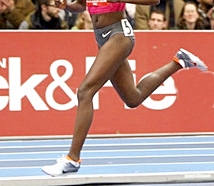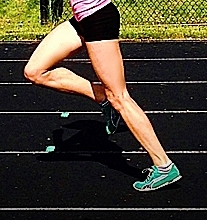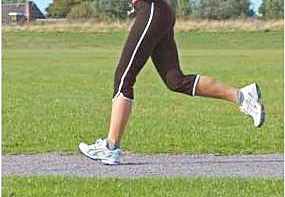Forefoot running increases mechanical demands on the ankles, which may increase the risk of an Achilles injury. This is actually a speculation, or a myth because no evidence has directly linked forefoot running to an Achilles injury.
Why Some Experts Think Forefoot Running Causes Achilles Injury

Studies of which heel strike runners switched to forefoot running, rarely, if ever, experienced Achilles pain, tearing, or rupture. Yet, many experts are quick to caution heel strike runners on the potential dangers of forefoot running on the body’s strongest, most durable tendon.
Why?
Forefoot running increases plantarflexion moments at the ankle. This observation led experts to hypothesize that forefoot running increases internal loading on the Achilles, thereby increasing the risk of tearing or rupture, especially in heel strike runners who switch to forefoot running. BUT….
Achilles Injury is Actually Higher in Heel Strike Runners!
Achilles injury accounts for more than 10% of the chronic running injuries in joggers, and most joggers heel strike. Therefore, statistically speaking, Achilles injury is correlated with heel striking, not so much forefoot striking.
What is more, Sinclair et al. (2014) found no significant difference between Achilles tendon loads in heel strikers who switched to forefoot striking in a zero drop minimalist shoe.
Click here to find out how ‘heel whipping’ occurs only in heel strike running, which causes Achilles injury.
Why Some Forefoot Runners Experience Achilles Soreness
A forefoot running learner may experience Achilles soreness, which is only temporary until the tendon adapts. Repeated mechanical loading of the Achilles tendon leads to adaptation rather than injury in forefoot running learners. This repeated “mechanical loading” is not as bad as what most of the literature makes it out to be.
 It takes a lot to rupture the Achilles considering it is more than capable of holding up to 2000 lbs.
It takes a lot to rupture the Achilles considering it is more than capable of holding up to 2000 lbs.
The lack of evidence on the forefoot running- Achilles injury link means conclusions regarding Achilles tendon pathology cannot be drawn – especially since Achilles injuries are a rarity in habitual barefoot populations.
Heel Striking Associated with More Injuries Overall
The claims regarding the role of forefoot running in directly causing Achilles tendon injury are virtually unsubstantiated. Meanwhile, the benefits of forefoot running are greater as heel strike running increases external loads on the musculoskeletal system.
Evidently, Achilles injury seems to be the only worry related to forefoot running whereas the distinct impact peak, high angular momentum and instantaneous rates of loading classify heel strike running as the most forceful way to run leading to the highest rates of repetitive stress injury and chronic injury.

I would rather run forefoot because it reduces knee pain, back pain and shin splints, and take the small risk of an Achilles injury over remaining a heel striker, plagued with persistent and recurring injuries whereby fighting these injuries with a heel strike is a losing battle.
More on Forefoot Running:
Knee Pain From Running – Find out how heel strike running leads to osteoarthritic knees across time.
Forefoot Running Shoes – Read my reviews on the best barefoot like shoes for forefoot running.
Overpronation – Learn how to avoid overpronating with this simple suggestion!
The Role of the Achilles Tendon in Forefoot Running – Learn how forefoot runners use the Achilles tendon to their advantage.
Why Take Smaller Steps – Learn why shortening your stride during forefoot running takes load off the hips and knees.
Don’t Overthink How You Run – Understand why it’s important to avoid the pitall of obsessing over your mechanics while you run.
References:
Magnusson, S.P., Langberg, H., and Kjaer, M., 2010. The pathogenesis of tendinopathy: Balancing the response to loading.Nature Reviews Rheumatology, 6, 262–268
Sinclair et al. Investigation into the kinetics and kinematics during running in the heelless shoe. Footwear Sci, 2014; 6(3):139-145.
Bretta Riches
BSc Neurobiology; MSc Biomechanics candidate, ultra minimalist runner & founder of RunForefoot. I was a heel striker, always injured. I was inspired by the great Tirunesh Dibaba to try forefoot running. Now, I'm injury free. This is why I launched Run Forefoot, to advocate the health & performance benefits of forefoot running and to raise awareness on the dangers of heel striking, because the world needs to know.
Latest posts by Bretta Riches (see all)
- Does Foot Strike Really Matter in Running? YES! - 17/04/2024
- Heel Lifts Increase Injury in Runners - 16/04/2024
- Are Minimalist Shoes Good for Seniors? YES! - 14/04/2024

Leave a Reply